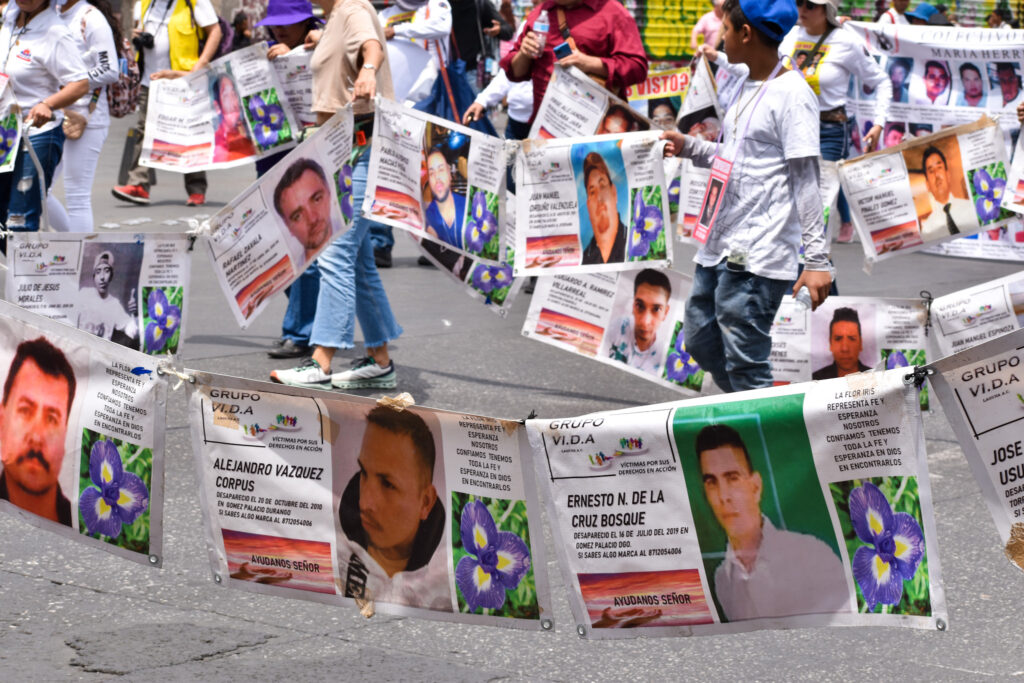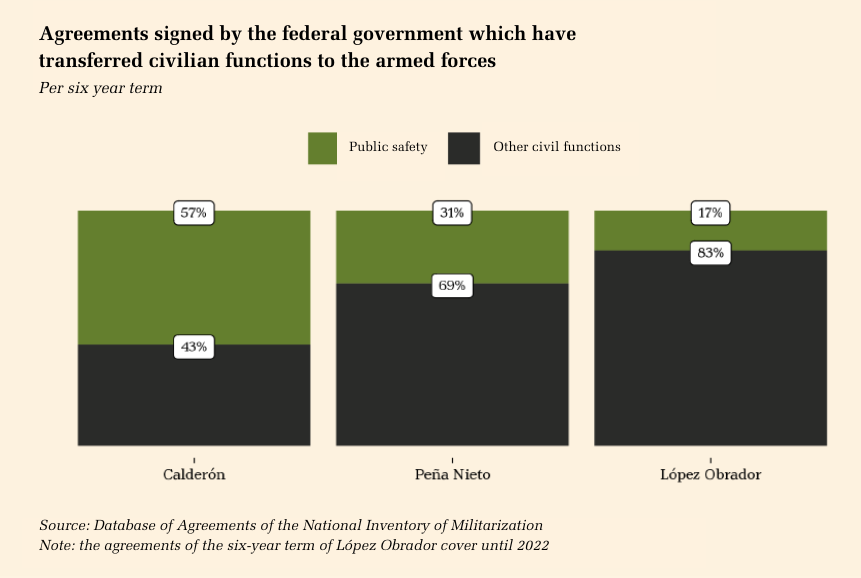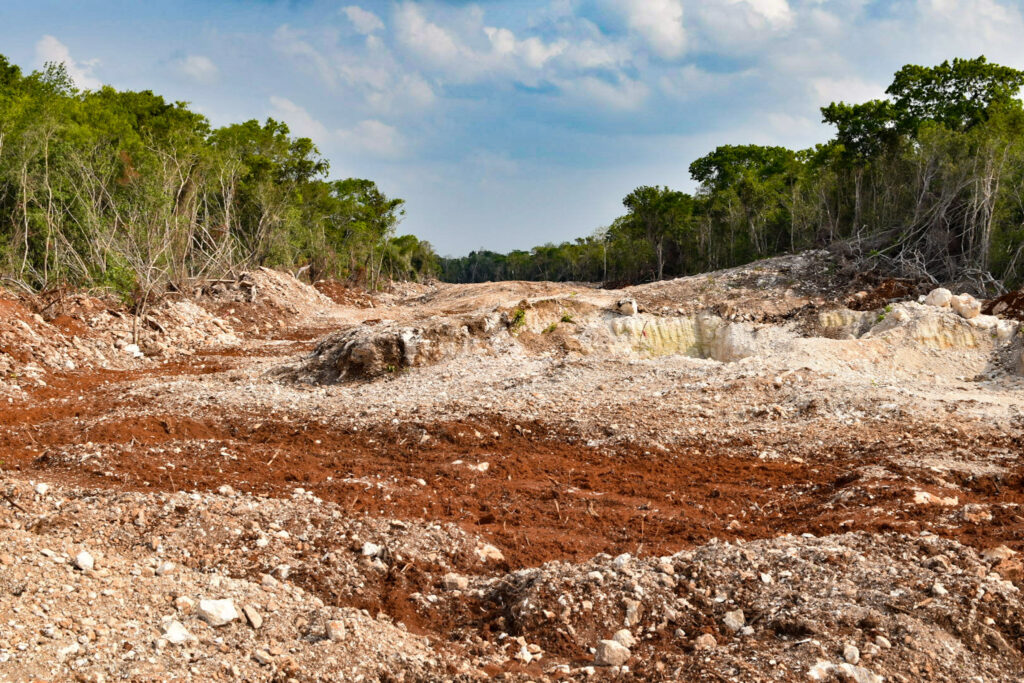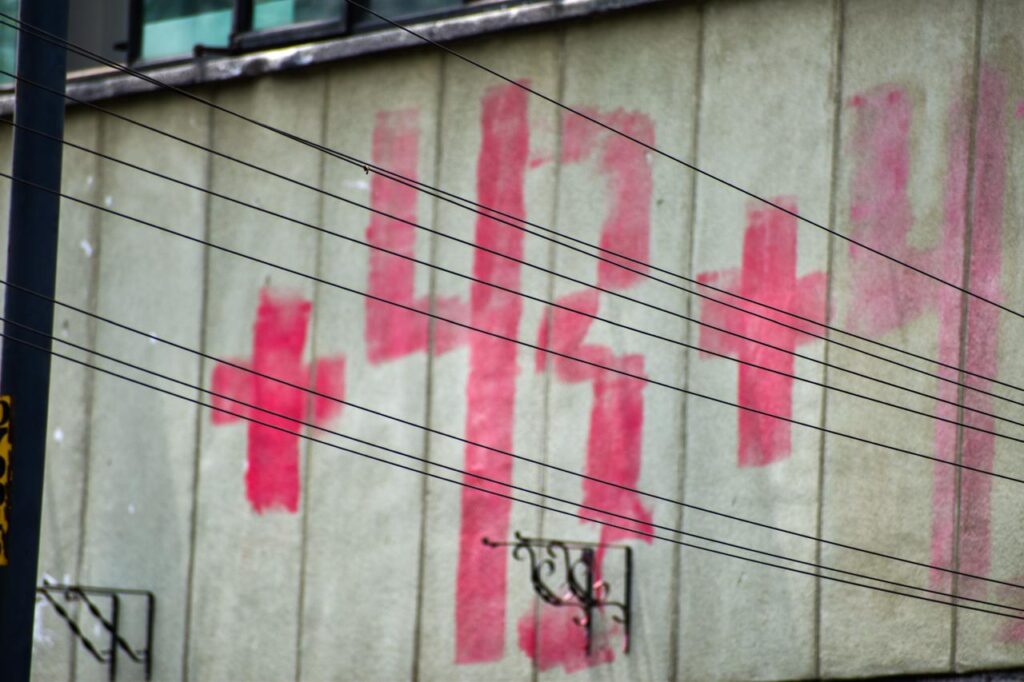Claudia Sheinbaum’s victory in June marked a watershed moment for Morena (Movimiento de Regeneración Nacional, Movement for National Regeneration), the party she had helped build since 2011. Together with its allies in the coalition Juntos Haremos Historia (Together We Will Make History), Morena won seven out of nine disputed state governments and achieved a supermajority in both chambers, with the help of some political “arrangements.” Around the globe, the result was celebrated as a symbol against the resurgence of far-right politics elsewhere. Nonetheless, the election was arguably the most violent in Mexican history. Thirty-six candidates were murdered, and over one thousand candidates and precandidates withdrew due to political violence. Ballot boxes were stolen, and some 175 voting booths could not be installed due to high levels of insecurity and conflict. But violence was not the only hindrance to electoral democracy. Political favors in return for loyalty and the creation of divisions among former alliances—all practices reminiscent of the former state party, Partido Revolucionario Institucional (PRI)—remained in place.
The elections displayed what Mexicans might call a simulated democracy. In the new government line-up, the same names appear but in different positions. Morena promoted controversial figures: Omar García Harfuch, for example, who had served as the state coordinator of the Federal Police in Guerrero during the disappearance of forty-three students from Ayotzinapa—the most infamous case of violence by state forces in Mexico’s recent history—was appointed Secretary of Security. Some elected representatives committed fraud by taking positions designated for underrepresented groups. The institution overseeing the elections, the Instituto Nacional Electoral, had reserved sixty-three seats for indigenous people, Afro-Mexicans, migrants, people with disabilities, and LGBTQIA+ people, but at least ten candidates have been accused of falsely claiming indigenous or Afro-Mexican identity. Only 60 percent of the population voted in the election, and 2 percent of votes were recorded as invalid as a result of cross-outs. The opposition, such as the figure of Xóchitl Gálvez, was certainly not an option for those that still remember the Partido Acción Nacional (PAN) and PRI governments that came before. While there could be many explanations for a low turnout, we must also understand the election in the context of war.
The Mexican government has led a “war on drugs” since 2006, transforming the country through the militarization of everyday life. Mexico exemplifies a highly militarized and brutalized form of capitalism where the lines between criminal and legal enterprises blur, and the military assumes an important role in refitting spaces to capital needs, oscillating between being a disciplining and economic actor. During the administration of López Obrador (2018–2024), Sheinbaum’s predecessor and the founder of Morena, the state granted the military a primary role in business—in civilian functions such as constructing public infrastructure and transportation. As a result, Mexico’s executive branch has become more dependent on the military than ever before.
Military inheritance
In 2007, when President Felipe Calderón (2006–2012) declared a major militarization of Michoacán and some northern Mexican states, the US-coined term “war on drugs” entered the Mexican political debate with force. However, the policy to reduce drug consumption in the US through a sole focus on the supply side, by killing leaders of so-called cartels or through special operations in Mexico, preceded the “war on drugs” and dated back to the 1970s. Violence has nonetheless spiraled since Calderón’s declared “war.” According to official figures, there have been over 400,000 homicides and more than 120,000 missing persons since 2007. Impunity levels stand at about 96 percent of cases. Official recorded deaths of police and military personnel are significantly lower in comparison, with approximately 802 police killed on duty between 2013 and 2018.” As the war on drugs blurred the line between “criminals,” who could be killed with impunity, and civilians, forced disappearances, torture, and arbitrary detentions became an everyday occurrence. While the perpetrators aren’t always identified, local, state, and federal police and the military are frequently implicated in widespread violence.

Source: Inés Durán Matute
Cases against soldiers are typically restricted to military courts, despite legal efforts to change this. They hardly fear the civilian judiciary or the recommendations of the National Human Rights Commission—which collects complaints but has no competence for sanctions. To legally protect soldiers, a 2007 decree appointed soldiers as Federal Assistance Forces for “situations of turbulence or alteration of social peace.” However, a constitutional ruling maintained “public security institutions will be civilian.” Though various governments repeatedly discussed laws to increase the military’s presence in public security, they ultimately considered them too politically costly to be pursued. In 2017, a controversial security law passed by the Peña Nieto government which furthered the role of the military in civilian matters was repealed for being unconstitutional. The human rights consequences for the legal inconsistencies and protection of the military were disastrous.
Responding to popular discontent of the mid-2010s, Andrés Manuel López Obrador promised to end the war in his 2018 presidential campaign. During his government, he not only failed to achieve this promise, but the country recorded its highest death tolls. Rather than a break with prior politics of security, López Obrador’s “Fourth Transformation” opted for an authoritarian stance and granted greater power and purview to the armed forces. In 2019, López Obrador abolished the scandal-stricken Federal Police, and Congress created a new security force, the National Guard. But the changes were mainly nominal—76 percent of its members had come from the military or navy, making the National Guard highly controversial since its inception. In 2020, videos circulating online showed armed National Guard personnel chasing unarmed migrants close to Mexico’s Southern border, demonstrating their function in anti-migration operations rather than in anti-crime policies.
In May 2020, López Obrador finally achieved what his predecessors could not: via decree, he formally involved the armed forces in public security operations, including detentions and arrest warrants, significantly increasing military capacities. During his campaign, had explicitly promised not to take such an action as president. Through eighteen other decrees, López Obrador expanded the military’s functions and transferred 103 civil functions to the military. Like previous governments, López Obrador cited widespread violence to justify military expansion. Building on the various “war on drugs” policies implemented since 2006, the Mexican military’s authority today extends to migration enforcement, customs and airports supervision, social programs management, vaccine and medication distribution, science and research, and infrastructure construction, operation, and administration.

Even as López Obrador’s government implemented widespread austerity measures from 2018–2024, the armed forces continued to grow. Over this period, budgets for the Secretariat of National Defense (Sedena) and the Secretariat of the Navy (Semar) grew by 121 percent and 63.8 percent, respectively, together receiving $112 million in 2018 and $331 million in 2024.1 Meanwhile, health, science, and the judiciary saw funding cuts, and civilian institutions were partly dismantled. During López Obrador’s term, the number of people without access to health services increased considerably. In addition, the broad transfer of public functions to the military has meant that even parts of the civil budget bolster the military budget. After the finance ministry, Sedena eliminated the second-highest allotment of trusts (fideicomisos), which form a discretionary supplemental budget. What these figures show is that during the past six years, the López Obrador government has deepened and intensified an ongoing militarization process by granting armed forces more power, a larger budget, and an expanded scope.
Military business
Despite few official links between foreign direct investment and military intervention, many soldiers deployed to fight the “war on drugs” in the late 2000s were sent to Northern states that house crucial investment assets. The ties between military and business have only deepened under López Obrador, as the military has become an economic actor in its own right. To enable this transition, the government created the state company Olmeca-Maya-Mexica (OMM) to operate under the control of armed forces. OMM’s mission is “to manage, control, supervise, operate, and exploit national assets and companies for various economic activities.” Today, OMM administers airports, fuel centers, and tourist services including hotels, national parks and museums.
The military business stretches from transportation and communication infrastructure, including the airline industry. The government bought the extinct bankrupt national airline Mexicana de Aviación for approximately $48 million and granted it to the armed forces. As the Director of Advocacy at Mexico Unido Contra la Delincuencia wrote:
Sedena and Semar control a total of thirty Majority State Owned Enterprises. Twenty of these companies belonged to the Secretary of Infrastructure, Communications and Transportation, but with the dismantling of this civilian institution, the armed forces have not only taken over the management of these companies but will be the main beneficiaries.
The government has also granted the military control and ownership of controversial megaprojects, such as the so-called “Maya” Train, the Interoceanic Corridor and the new International Airport Felipe Ángeles in Mexico City. The military is involved in constructing these state-led infrastructure projects, which are accused of disregarding labor and environmental costs and bypassing legal procedures. Through these projects, the military is meeting the requests of international financial institutions: to “fill in critical infrastructure gaps.” But the military’s functions are not limited to construction. For the so-called “Maya Train,” Sedena created a subsidiary tourist company, Servicios Turísticos Itzamná, which will be building six hotels and a casino on the train route.
These shifts are not subordinating economic interests to military strategy. Rather, the government has created a powerful economic actor with military resources, and the public has almost no means to contest their activities. The protagonism of the military in state-owned corporations results in opaque and secretive management of public resources, with the benefits streaming to mostly a small military elite.

Source: Inés Durán Matute
Militarization of energy
Corporations do not necessarily oppose the military’s role in infrastructure. In fact, they are rather supportive of a state that prepares the terrain for capital accumulation. Energy links—from gas pipelines, refineries and liquid gas terminals to additional energy production through hydro and solar—and the multimodal transport corridors—container ships, trucks, trains, alongside an interconnected ports, roads and rail system—are useful and necessary for private corporations competing in global markets.
Since 2007, the Mexican military has been involved in economic activity and even in construction tasks for the federal government for infrastructure that did not require public tenders. Several of the military’s subcontractors and partners have been difficult to trace. Moreover, Defense and Marines have long been involved in providing protection to Mexico’s state-owned oil firm PEMEX and securing its energy supply. In 2013, the Defense Secretary acquired a small wind park close to the military airport of Ixtepec in Oaxaca, “Granja SEDENA,” operated by Danish turbine producer Vestas. As in other energy projects, the project’s land deals were highly contested.
Militarization in Mexico is historically tied to a specific, fossil-fuel oriented, if partly state-owned vision of the energy system. PEMEX, Mexico’s debt-stricken oil firm has long been a highly symbolic entity as a provider of accessible fuel and jobs, and López Obrador has placed significant rhetorical emphasis on restoring state ownership of this essential resource. But the (re-)nationalization of the energy system has only been implemented in fragments. It remains premised on fossil fuels and benefits large consumers, like industrial producers.
Examining the energy system reveals the extent of Mexico’s militarization and growing dependencies on global economic actors. The Peña Nieto government secured contracts for gas pipelines currently operating or under construction, against the concerns of inhabitants and violence against environmental and land defenders. López Obrador heavily criticized these pipelines: until 2022, they were not fully functional and did not deliver the contracted amount of gas, but companies nevertheless charged the Mexican state. The government finally renegotiated some pipelines into joint ventures with state-owned Comisión Federal de Electricidad and arranged for additional pipelines as well to import shale gas from the US.
One major project under construction, a 715-kilometre marine gas pipeline running from Texas to the Yucatán, promises to transport more than 1.3 billion cubic feet (MMPCD) of natural gas daily. The project, named Puerta al Sureste, allows the Canadian corporation TC Energy to be part of key infrastructure projects handed over to armed forces. “This is about building an entire electricity system in the forest of the [Yucatán] peninsula,” stated the head of the CFE, Manuel Bartlett Díaz. Environmental defenders have dubbed the recent investments into oil and gas expansion as Proyectos de Muerte (Projects of Death). Weak or absent environmental licenses, ecological damage from pipeline leaks, illegal tapping, land conflicts, and pipeline accidents—including explosions—have intensified insecurity, violence, and toxicity for local inhabitants.
Those who protest these megaprojects have faced arbitrary detention, repression, and selective assassinations—over 102 environmental defenders have been murdered in López Obrador’s term. Such was the case of Samir Flores Soberanes, the first land defender killed during Lopéz Obrador’s administration in 2019 after protesting against Proyecto Integral Morelos, an energy and industrialization project in Mexico’s central region. Activists and campaigners have also reported being followed by armed forces, paramilitary groups, and organized crime groups aligned with fossil fuel interests. For locals, the intersections between the legal economy, violence, and state-led militarization are a constant threat.

Source: Inés Durán Matute
War and economy
Many claim that in order to keep the Mexican economy running, the state must protect the economy from ongoing violence. While this argument legitimizes the role of the military in the economy, there are few signs that Mexico’s macroeconomic indicators depend on its pacification. International institutions often commend Mexico for sustaining economic growth despite war and criminal activity.
When the IMF visited Mexico in October 2023, it boasted of “record-low unemployment” and “robust private consumption,” which has driven over 3 percent growth. The banking system was resilient to shocks, and the outlook remained stable, as “luckily,” some commentators said, López Obrador inherited a low deficit of 2 percent of GDP from his predecessor. After the huge drop of the peso in international markets during the pandemic, the currency sharply appreciated, earning the title of the “superpeso,” the best-performing currency in the world in 2023. Currency appreciation was attributed to nearshoring, increased remittances and exports, and high interest rates. In these indicators, socio-ecological issues and violent conflict are rarely mentioned.
Precisely in those states in Northern Mexico which have seen atrocious rates of violence, US and Canadian corporations now see promising locations for manufacturing that avoid long and complicated supply chains which proved vulnerable during the pandemic. López Obrador promised massive tax cuts for e-vehicle producers and others, and Sheinbaum will likely offer the same. Mexico already has the OECD’s lowest tax-to-GDP ratio. These moves have attracted Chinese firms to the country as well. While some have expressed concerns that rising land prices—as owners await potential investors like Tesla—may deter companies, the real dangers will likely affect local communities, who may suffer intensified violence and land conflicts in an already volatile context.
The blurred boundaries between legal and illegal economies have meant that violence and economic growth continue to coexist across the country, benefiting a variety of actors. In the state of Chiapas, the home of the Zapatista rebellion and of dozens of indigenous communities, mining has led to dispossession, violence, environmental and health harms, and forced displacement. In 2024, civil society organizations estimated that over 3,000 residents had been forcibly displaced during the first forty-three days of the year in the Southern region alone. La Revancha mine in Chicomuselo is a key example of the dire situation. Originally run by the Canadian company Blackfire, the Federal Attorney’s Office for Environmental Protection closed down the mine in 2009 after the murder of anti-mining activist Mariano Abarca. Since 2023, however, La Revancha has been operating illegally under an armed group, for the extraction of barite, a mineral used in drilling oil wells whose primary consumer is the oil industry. La Revancha is now the site of an armed confrontation between different groups seeking control as well as local population defending their communities and lives.
Such conflicts are seen throughout Chiapas, which has been on the verge of a civil war since September 2021, as warned by the EZLN. Paramilitaries, self-defense groups and cartels are fighting over territory with the complicity of the government. The scenario has not changed with Sheinbaum’s ascendance into power. In October, the EZLN denounced threats, abuses, and harassment against the support bases; soon after, a local community defender and Tsotsil priest, Father Marcelo Perez, was assassinated. Violence in Chiapas, like in other regions of the country, seems to be the result of economic investment.
López Obrador’s government did little to hold investors and corporations accountable for the environmental, social, and violent impacts on the country. Rather, the continuation of the “war on drugs” consolidated an extractivist model, focusing on sectors in need of territorial control. As Carlos Slim, Mexico’s richest businessman, commented on López Obrador: “the important thing is that he has respected the private sector, which I believe is working well.” With renewable energy corporations, the relationship has been more tense; investments in that sector have gone down considerably since 2018, as some projects were stalled. Moreover, the renegotiation of NAFTA, which led to the United States–Mexico–Canada Agreement (USMCA), deepened Mexico’s economic subordination to its northern neighbors. Mexico remains highly dependent on US economic activity; US-based corporations efforts’ to reshape supply chains still utilize low-wage labor in Mexico for nearshoring and export.
A new era?
López Obrador promised to initiate a new era in Mexican politics, but the past six years brought fewer changes than expected. The perverse effect of this political reversal is most clearly seen with the government’s response to the Ayotzinapa case. López Obrador initially promised to investigate the disappearances and murders. His first act of government on December 4, 2018, was to create the Commission for Truth and Access to Justice (Covaj). However, a study by Quinto Elemento Lab found that by 2022, the Covaj had been compromised and the special prosecutor unit for the case was unable to operate. The government even pushed for the dissolution of the International Independent Expert Commission which had worked with families since 2014 to solve the case. As a recent communique by the Ayotzinapa families signals, the López Obrador government withheld information and only delivered fifteen of over 800 documents of military intelligence, and opted to further the opacity, discrediting and silencing families and their lawyers. In 2024, marking the tenth anniversary of the disappearances, families, alongside thousands of supporters, took to the streets to keep demanding truth and justice.

Source: Inés Durán Matute
The state has continued to express disdain for victims’ families and their pain. Today, over 100 organizations are dedicated towards searching for missing relatives, facing numerous obstacles from the state and operating in an environment of fear. They have been doing the work governments refuse to do, investigating what happened to the disappeared without any budget. Many are mothers searching for their missing children; some of them have been killed while searching. Their searches have resulted in disturbing findings, such as the discovery of numerous mass graves, including two clandestine crematoriums and seven mass graves in Guadalajara. The López Obrador government had underestimated both the crisis of disappearances and the risks borne by the families who continue to search for their loved ones. Those who search for the forcibly disappeared did not vote for Sheinbaum. During the election, they organized the campaign, “I exchange my vote for my missing child,” as an act of protest.
Will Sheinbaum break from the legacy of López Obrador? Over the next six years, the relationship between economy and war will shape Sheinbaum’s mandate, but her track record casts doubt on the likeliness of a rupture. Under Sheinbaum’s mayorship, Mexico City was among the states that signed the greatest number of contracts with the Defense ministry. Sparking criticism from activist groups, her government tried to impose greater control on la Glorieta de las y los Desaparecidos, a collective occupied space for memory in the financial district. Feminist collectives and activists also criticized Sheinbaum for her administration’s repressive and militarized responses to protesters, as seen during the March 8 women’s marches. Today the conflict with feminist groups has reignited.

Source: Inés Durán Matute
Since her victory in June, Sheinbaum has strengthened ties to the military. In September, she led a ceremony before hundreds of militaries at the Military College where she confirmed that the “humanist armed forces” will continue their role in constructing infrastructure. On the last day of his term, López Obrador signed a reform validating military intervention in all civil duties and placing the National Guard formally under the command of the Defense Secretary. Sheinbaum’s inauguration speech the following day suggested a continuation of her predecessor’s aims. Speaking to the Mexican people and the world, she denied the militarization of the country and the violations of human rights, instead celebrated the armed forces as “structures with the discipline, education and manpower necessary to respond immediately” to the problems facing the country’s development. Despite this praise, Sheinbaum cut the Defense budget in 2025, part of a broader “republican austerity” which has shrunk funding for education and other sectors. Her government has reduced state funding for OMM, the “Maya” Train and the acquired Mexicana de Aviación.
Despite promising continuity through “the second floor of the Fourth Transformation,” Sheinbaum’s election initially triggered alarm for the business world. The peso experienced its biggest drop since the pandemic, a result of the possible loss of counterweights in the government and the approval of an extreme, eclectic and controversial package of constitutional amendments. In response, Sheinbaum has since aimed to transmit confidence to corporations. She held several talks with the Consejo Coordinador Empresarial, Mexico’s powerful business association, insisting on the business potential of US nearshoring efforts and the possibilities of a renewable energy value chain. She declared a proposed labor reform, which would reduce the working week from forty-eight to forty hours, would first require consensus from the business community in order to pass.
Many have suggested that Sheinbaum’s past as an Intergovernmental Panel on Climate Change author and climate scientist will usher the country towards renewables and away from fossil fuels, including a reliance on PEMEX. While such a transition could reduce greenhouse gas emissions, it would not significantly alter the ownership structure of energy generation or solve the violence and conflict associated with energy projects. Proposed solar and wind projects—such as the Ticul solar project in Yucatán and wind parks in Oaxaca—have faced significant local opposition, as they often fail to bring expected benefits to communities. Plans published by the past government project rising energy generation—and there are few signs Sheinbaum’s team will move away from this trajectory, given the proposed expansion of López Obrador’s “Fourth Transformation.” Sheinbaum is likely to continue building state-run infrastructures in close partnership with the firmly established military business, cementing the ties between the state, war, and economy.
FootnotesFiled Under

